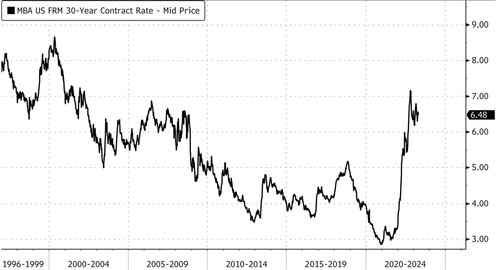Goldman Sachs chief economist Jan Hatzius told clients he views today’s consumer price index report “as supportive of our call for a pause at the June FOMC meeting because the shelter stepdown looks increasingly durable.”
Shelter costs, which comprise about one-third of the CPI weighting, increased another .4% in April on the month and up 8.1% compared to the same month last year. However, recently, shelter costs have been decelerating.
US home prices are starting to slide in certain areas. We pointed out last month that shelter costs have likely “topped out.”
But shelter has topped out:
– MoM Shelter rose just 0.66% in March, down from 0.79% in Feb and the lowest since November 22
– MoM Rent rose just 0.45% in March, down from 0.71% in Feb and the low4est since March 22 https://t.co/M7npCURsOw pic.twitter.com/0EcAeLP9kO— zerohedge (@zerohedge) April 12, 2023
More evidence of this was published in the National Association of Realtors report this week, which shows home prices have declined in more areas of the country than in over a decade during the first quarter, according to The Wall Street Journal.
NAR’s report showed housing markets are falling on the West Coast while rising in Midwest, South, and Northeast. The most significant declines were recorded in California and the Mountain West. San Francisco posted a 14.5% median single-family existing-home sale-price decline compared with the quarter last year. Also, towns that boomed the most during the pandemic, such as Austin, Texas, and Boise, Idaho, which saw an influx of Californians, slumped more than 10%.
High mortgage rates have heavily weighed on home-buying demand as supply has been limited. The effect of monetary tightening by the Federal Reserve is beginning to filter through where more regions in the US are recording home price declines. On an annual basis, price declines have been seen in 31% of the 221 metro areas monitored by NAR, the highest in over a decade.
The deceleration is a welcoming sign for home buyers, but Lawrence Yun, NAR’s chief economist, describes the unevenness of the market:
“Generally speaking, home prices are lower in expensive markets and higher in affordable markets.”
Yun did point out that if inventory shortages persist, it could make home price declines “short-lived.”
NAR’s data shows US median single-family existing-home sale prices fell by .2% in the quarter compared to a year earlier to $371,200. This was the first year-over-year price decline in the first quarter since 2012.
In a separate note via NAR, Yun was quoted as saying, “Federal Reserve’s most recent rate hike was unnecessary, and he expects the Fed will stop raising interest rates further.”
Yun explained that the Fed’s aggressive rate hike campaign triggered regional bank turmoil and hurt the housing market.
So, to sum up, shelter costs have peaked as the Fed’s most aggressive interest rate tightening campaign has ignited the most severe affordability crisis in years. Overall, home prices are beginning to wane. For a more substantial decline, there needs to be an influx of inventory to hit markets.



